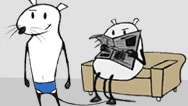Map of the Human Heart
- Teacher Resource
- Posted 09.26.03
- NOVA
This animated feature, part of the NOVA: "Cut to the Heart" Web site, illustrates how the chambers of the heart contract and relax in synchrony to push blood through the pulmonary and systemic loops of the circulatory system. Watch oxygen-depleted blood being pumped to the lungs, where it acquires oxygen before traveling back to the heart and ultimately being distributed throughout the body.

- Media Type: Document
- Size: 1 byte
- Level: Grades K-8
-
Log in to Teachers' Domain to download, share, rate, save, and match to state standards.
Source: NOVA: "Cut to the Heart" Web site
Background
To meet these variable demands, heart rate increases or decreases. In addition, blood vessels dilate to deliver more blood, or constrict during times when less blood is required. Usually, our heart works infallibly, beating about 100,000 times a day, or some 2.5 billion times in an average lifetime. Unfortunately, like other muscles and systems in the body, the heart and circulatory system can't always keep up with the demand.
Heart disease is the number-one cause of death in the United States, resulting in more than 700,000 deaths annually. Coronary artery disease (CAD), a narrowing of the arteries supplying blood to the heart, is the most common form of heart disease. Although CAD often begins when a person is very young, the disease's symptoms are usually not felt until late in a person's life. Increasingly constricted arteries significantly weaken the pumping action of the heart and, in the most extreme cases, can cause congestive heart failure -- a potentially lethal buildup of fluid in the lungs and other body tissues.
Among people more than 70 years old, about 8 out of 1,000 are diagnosed with congestive heart failure each year. This means not that their heart has stopped working, but that their heart is not pumping effectively enough to meet their body's need for oxygen-rich blood, either during exercise or at rest.
Fortunately, treatments do exist for patients who have suffered congestive heart failure, including medications that lower blood pressure, lower heart rate, and improve the efficiency of the heart's contractions. The best treatment for congestive heart failure, however, is the prevention of heart disease in the first place. A healthful diet, regular exercise, weight control, and abstinence from smoking can all help prevent coronary artery disease and other forms of heart disease.
Questions for Discussion
- Why does the heart separate the oxygenated and deoxygenated blood?
- Why does the heart have valves?
- Why do we need blood circulated through the body? What does it do?
Related Resources
-

Marathon Challenge
Students take each other's pulses at rest and after exercise to determine recovery times.
-

Marathon Mouse
With an "exercise pill," researchers turn couch-potato rodents into champion runners.
-

OPERATION: Heart Transplant
Perform a virtual heart transplant in 19 easy steps with this interactive feature from the NOVA: "Electric H...





